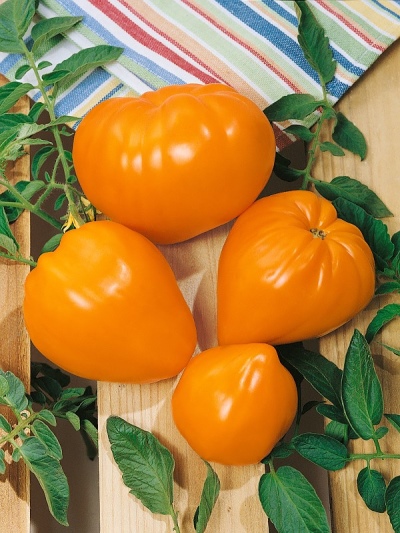
- Authors: Kachainik V.G., Gulkin M.N., Karmanova O.A., Matyunina S.V. (Agrofirma Aelita LLC)
- Year of approval: 2018
- Category: grade
- Growth type: indeterminate
- Appointment: fresh consumption, for pickling and preserving, for juice, for ketchup and tomato paste
- Ripening period: mid-season
- Ripening time, days: 105-110
- Growing conditions: for open ground, for film greenhouses
- Bush height, cm: 160-180
- Foliage: medium
One of the large-fruited representatives of indeterminate varieties and hybrids is the Orange Bull Heart. The magnificent plant produces highly decorative fruits with a bright color of a clean palette, whose composition allows them to be eaten by people with allergies to red tomatoes. The fruits are intended for fresh consumption, for salads, making juices, ketchups, tomato paste.
Breeding history
The authorship of the breeding belongs to the breeders V.G. Kachainik, M.N. Gulkin, O. A. Karmanova, S. V. Matyunina, who operate in Agrofirma Aelita LLC. The variety was approved for use in 2018.
Description of the variety
Tall bushes reach 180 cm when cultivated in greenhouse conditions and up to 169 cm in open ground. The plant has a thin, liana-like, light green stem, no more than 1 cm thick, which requires growing on a trellis or support. The flowers are light yellow in color and are collected in racemose intermediate inflorescences. Shoots are covered with dense dark green elongated foliage of medium size with a low degree of dissection, the stalk is articulated. The tomato is prone to the active formation of stepchildren, as a result of which their constant removal and the formation of a bush in 1, less often in 2 stems are necessary.
The main qualities of the fruit
Unripe large, heart-shaped, slightly ribbed tomatoes have a light green color; upon reaching technical ripeness, the fruit takes on a rich orange color with a greenish spot near the stalk, which disappears at the time of full ripeness. Fruit weight 300-350 g.
Taste characteristics
The dense, fleshy flesh has a rich and pleasant sweet taste with a barely noticeable piquant sourness. Tomato is recommended for baby food, as it is characterized by increased levels of pectins and sugars, B vitamins and antioxidants.
Ripening and fruiting
The variety belongs to the mid-season - the ideal ripening period is 105-110 days, but in reality they often have a wave character, and the harvest takes place from July to September.
Yield
Orange bovine heart is positioned as a variety with a high return - up to 5 kg of tomatoes are harvested from the bush in the open field and up to 12 kg in greenhouses, subject to compliance with agrotechnical requirements.
The timing of planting seedlings and planting in the ground
Sowing seeds for seedlings is carried out in the first half of March, planting in the ground - from May 15 to June 5, but much depends on the region of cultivation and the individual characteristics of the site.

Growing tomato seedlings is an extremely important process, because it largely depends on whether the gardener will be able to harvest at all. All aspects must be taken into account, from seedbed preparation to planting in the ground.
Landing scheme
The bushes are planted according to the scheme 60X50 cm, the planting density is 3-4 roots per square meter.

Growing and care
Despite the recommendations for growing in 1 stem, the gardener will not be able to get a good harvest - the shoot simply will not pull out a large mass of large fruits, even in greenhouse conditions. That is why many people prefer to form a two-stem bush, which gives an optimal balance of load on the area and yield. As practice has shown, a 3-stem bush is as ineffective as a single-stemmed one.
Seedlings are planted in a permanent place 60–65 days after sowing the seeds. The soil is enriched with organic matter, superphosphate, wood ash. A support is installed in the pits if the tomato is grown on a trunk. The plant is well shed after planting.
Subsequent care consists in timely watering, fertilizing, weeding, loosening, preventive treatments, pinching, shaping. All activities are carried out according to the traditional scheme for tomatoes. The principle of bush formation is slightly different, but it is also used for many indeterminate varieties.
Watering time is evening, once every 3-4 days. Water the plant at the root, trying not to touch the foliage. The next day, the soil must be loosened to provide oxygen access to the root system. Mulching eliminates this need. Fertilization is carried out three times during the growing season.




A plant needs different micronutrients at each stage of growth. All fertilizers can be divided into two groups: mineral and organic. Folk remedies are often used: iodine, yeast, bird droppings, eggshells.
It is important to observe the rate and period of feeding. This also applies to folk remedies and organic fertilizers.
Disease and pest resistance
The variety has strong immunity and high resistance to Alternaria, Cladosporium and Tobacco Mosaic Virus, and also perfectly resists late blight and gray rot. Nevertheless, prophylactic treatments with antifungal drugs are required.


Resistant to adverse weather conditions
Tomato is perfectly adapted to growing in areas of risky farming, it tolerates drought well, especially if grown in greenhouses. Waterlogging is more dangerous for him, in this case the roots may rot.
Growing regions
The variety is adapted for cultivation in the southern regions, it is successfully cultivated in the Crimea, Belarus, Moldova, and the North, North-West, Central districts are also suitable for it. The variety is popular in the Volgo-Vyatka, North Caucasian, Middle Volga and Lower Volga regions, Central Black Earth Region. The orange heart is grown in the Ural and Siberian regions, as well as in the Far East.

























































































